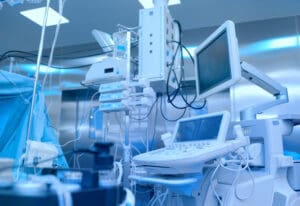Means of Protection standards
Both MOOP and MOPP fall under the category of means of protection (MOP) in medical electrical equipment and medical power supplies. This standard contains steps to minimize the risk of electric shock to ensure that no harm is caused by the electrical medical equipment. Shock is prevented in a number of ways, including preventing input contact, strict use of isolation and insulation, and a low leakage current to secondary parts. Meeting specified leakage current levels are one of the primary MOP requirements recognized by the IEC 60601-1 standard.
Methods used to achieve MOP standards consider various areas of a power supply. This includes:
- Solid insulation – must be compliant with 60601-1 dielectric strength standards.
- Air clearance – the shortest distance, as allowed by the standard, that can be measured between two conductive parts of the power supply through air.
- Creepage distance – the shortest distance when measuring along the surface of the insulating material that connects two conductive parts allowed by the standard.
- Protective earth connections – ground connections that disperse potentially harmful shocks into the earth, protecting both operators and patients. This definition also classes fuses and circuit boards on a medical device as a MOP.
Means of Protection for medical electrical equipment are tested using two different circumstances:
- Normal Condition – all MOPs remain in place and the leakage current stays within the acceptable limits. This is designed to test the functionality of protection under regular operating conditions.
- Single Fault Condition – a single MOP is removed and the leakage current remains within the limits. For instance, the earth ground connection is removed. In this example, it would be verified whether another MOP is effective in maintaining a safe leakage current.
Medical electrical equipment will achieve one MOP level if it only passes the first test, signifying a basic protection against electric shocks. However, if it passes the SFC then it will have two MOP levels and be considered as having reinforced insulation. Designing for 2xMOP is the goal to ensure safe operation of medical electrical devices and equipment.
What is MOOP
Means of operator protection (MOOP) addresses incredibly important safety parameters for operators of medical equipment such as doctors, nurses, or other clinicians. In order for a power supply to be classed as having a MOOP level it must achieve the following classification:
- 1xMOOP – isolation of 1500VAC, creepage of 2.5mm, clearance of 2mm.
- 2xMOOP – isolation of 3000VAC, creepage of 5mm, clearance of 4mm.

What is MOPP
Standing for means of patient protection, MOPP includes measures to reduce the risk of harm to the patient through electric shocks from equipment. Generally, MOPP standards are stricter than those for MOOP because patients may be more vulnerable. That being said, systems that achieve MOPP standards will be safe for both patients and operators. The classification for MOPP is:
- 1xMOPP – isolation of 1500VAC, creepage of 4mm, clearance of 2.5mm.
- 2xMOPP – isolation of 4000VAC, creepage of 8mm, clearance of 5mm.
Impact of IEC 60601-1:2006 standard
Both MOOP and MOPP are relatively recent developments, having been introduced in 2006 with the publishing of IEC 60601-1-8:2006. This standard outlines ‘General requirements for basic safety and essential performance’ in medical electrical equipment, with a collateral standard covering ‘General requirements, tests and guidance for alarm systems in medical electrical equipment and medical electrical systems’.

The IEC 60601-1 is intended to be used in conjunction with MOOP and MOPP as it defines minimum requirements for safety measures. For example, an important means of protection for patients and operators is suitable insulation. The standard defines the minimum insulation creepage and clearance for different voltages (see above).
The International Electrotechnical Commission (IEC) contains more than 150 member countries at the time of writing. As such, complying with IEC power supply safety standards is essential for designers and manufacturers who want their power supplies to see worldwide use.
As is the case with many IEC standards, the 60601 has gone through a number of iterations. The most recent is the consolidated IEC 60601-1:2005+AMD1:2012+AMD2:2020 CSV, which recognizes the fact that the 60601 standard shouldn’t be used independently. The steps in its development to reach this stage include:
IEC 60601 edition 1.0
Published in 1977, this was the first set of safety standards from the IEC regarding electrical medical equipment. At this time, it was known as IEC 601 and its primary goal was to protect qualified medical personnel when using equipment. The key aspects of safety addressed were mechanical and electrical safety of medical devices, as well as reducing the risk of electric shocks through protection measures.
The first amendment to the standard came in 1984 to address additional requirements brought about by the introduction of medical electron accelerators.
IEC 60601 edition 2.0
In 1988 came the 2nd edition and first full revision of the standard. This laid the foundations of MOPP, as the focus on the safety of medical devices used in the proximity of patients. Subsequent amendments in 1991 and 1995 were then made to account for the advancement of medical technology.
IEC 60601 edition 3.0
Building on the previous two editions, this is the most recent edition (at the time of writing) of IEC 60601. It was this publication that added MOPP and MOOP with a greater focus on risk management. It also provided additional scope for the standard’s requirements to be adapted for specialist equipment or unique scenarios. Following on from its initial publication in 2005, a number of updates were made to the standard in the following decade to address the safety and performance of medical electrical equipment.
Related publications
Under the ‘umbrella’ of IEC 60601 are a huge range of parts and specifications, each touching on a different aspect of electrical device safety for medical applications. The notable publications for power supply designers are:
IEC TS 60601-4-6
The IEC TS 60601-4-6:2024 contains voluntary guidance to help power supplies achieve basic safety and performance in regard to electromagnetic interferences. In this documentation you’ll find practical methods for establishing and enhancing EM resistance throughout the lifespan of medical electrical equipment. It covers a broad range of techniques and measures that can be used in the design, verification, and validation of related systems, including hardware, software, and firmware.
UL94V-0
This standard sets out flame resistance requirements for components used in electrical devices. Qualifying criteria includes:
- Less than 10 seconds of burning combustion under the application of a controlled flame.
- Flaming combustion time of 5 samples is less than 50 seconds in total.
- Samples don’t reach glowing combustion for more than 30 seconds after a second controlled flame is removed.
- No samples are burned to the mounting clamp.
- No samples drip flaming particles which ignite surgical cotton on contact.
Restriction of Hazardous Substances (RoHS)
Although there aren’t RoHS regulations at the federal level, many states have passed bills relating to the restriction of hazardous substances and materials present in electrical and electronic equipment (EEE). The goal is to protect human health and the environment from the harmful effects of substances like Mercury, Lead, and Cadmium.
Features of safe medical power supplies
Medical devices and electrical equipment can achieve two possible levels of MOP from electrical hazards – 1xMOP and 2xMOP. The latter is the level of protection you should be looking for as this indicates the supply has a double layer of protection. This is also equivalent to ‘reinforced insulation’ under IEC 60601-1. Whether you need a custom medical power supply design for devices, diagnostic equipment, or a specialist medical application, emphasis must be placed on safety and reliability.

In order for a piece of medical electrical equipment to meet the safety requirements the following areas should be addressed:
- Manage leakage current – While all devices will experience some loss of current through leakage, this must be minimized. In most cases, the limit is 100μA under normal conditions. Leakage current requirements for medical power supplies are generally much higher than for commercial power supplies.
- Appropriate power rating – Medical power supplies should be designed in consideration of the maximum current needed for the equipment application.
- Mounting – Your chosen power supply must have the right mounting options to match its applications. For instance, the MDHU100 series power module is designed to supply distributed systems, analog/digital subsystems, portable equipment, local power networks, and battery-backed systems.
- Thermal management features – Power supplies for medical equipment should remain cool while in use. During testing, it’s therefore important that the ambient temperature range of the application is considered and cooling options are selected accordingly.
- Dual line fusing – Medical equipment with protective earth ground contact requires fusing on line and neutral wires, which can be achieved through the power supply.
These safety guidelines assist medical power supply designers in meeting the requirements of medical electrical equipment and overcoming some of the challenges that are present in a unique medical environment.
Fully compliant power supplies for medical applications
When choosing a medical power supply manufacturer, it is important that their product not only adheres to safety standards, but will also remain effective and reliable throughout its lifespan.
At Wall Industries, we offer a wide range of medical power supplies that meet all general standards. If you can’t find what you need, we also offer custom power supply solutions which can be tailored to prioritize patient and operator safety. Our design team and manufacturing capabilities allow us to produce supplies that are safe and reliable in medical settings.
Get in touch to discuss your requirements.
